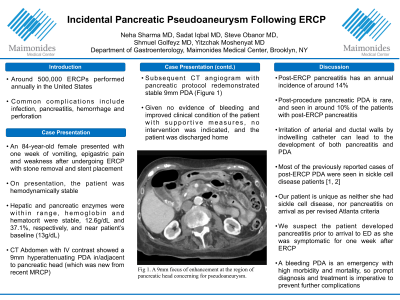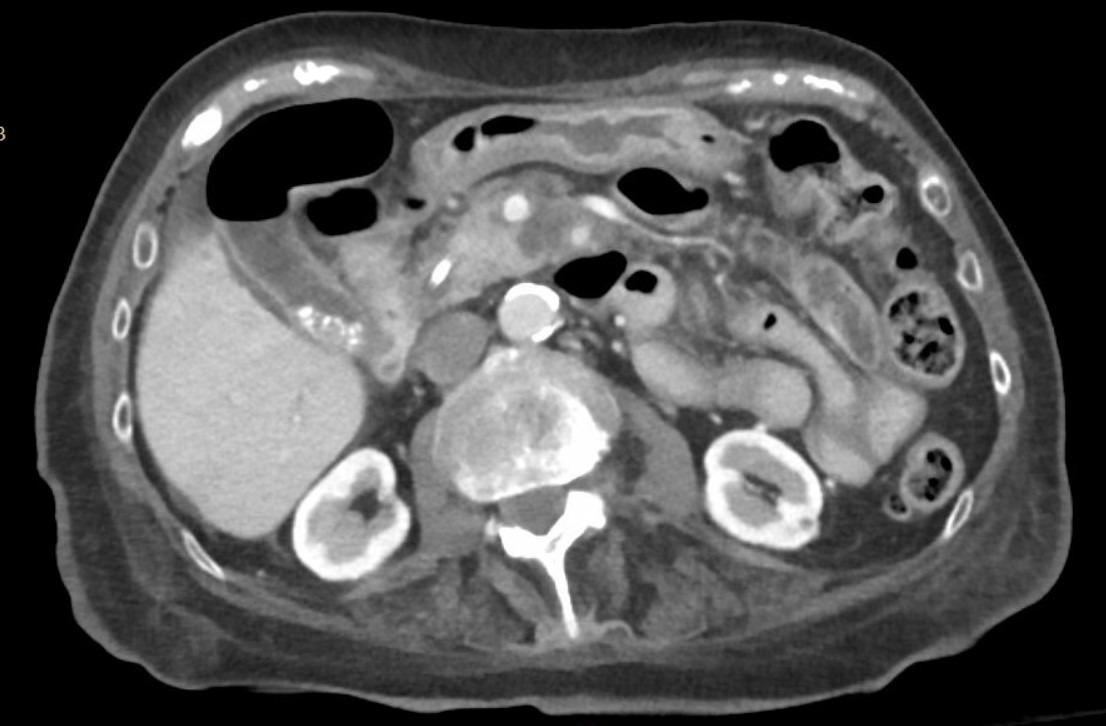Back


Poster Session A - Sunday Afternoon
Category: Biliary/Pancreas
A0027 - Incidental Pancreatic Pseudoaneurysm Following ERCP
Sunday, October 23, 2022
5:00 PM – 7:00 PM ET
Location: Crown Ballroom

Has Audio

Neha Sharma, MD
Maimonides Medical Center
Brooklyn, NY
Presenting Author(s)
Neha Sharma, MD, Sadat Iqbal, MD, Steve Obanor, MD, Shmuel Golfeyz, MD, Yitzchak Moshenyat, MD
Maimonides Medical Center, Brooklyn, NY
Introduction: ERCP is a commonly performed procedure, with up to 500,000 ERCPs performed annually. Commonly known complications include infection, pancreatitis, hemorrhage and perforation. Here we describe a case of pancreatic pseudoaneurysm (PDA) which resulted from Post-ERCP pancreatitis.
Case Description/Methods: An 84-year-old female presented to hospital with vomiting, epigastric pain and increased weakness for one week after undergoing ERCP with stone removal and stent placement. On presentation, she was hemodynamically stable. Hepatic and pancreatic enzymes were within range, hemoglobin and hematocrit were stable, 12.6g/dL and 37.1%, respectively, and near patient’s baseline (13g/dL). CT Abdomen with IV contrast showed a 9mm hyperattenuating PDA in/adjacent to pancreatic head (which was new from recent MRCP). For better characterization, a CT angiogram with pancreatic protocol was performed, which redemonstrated stable 9mm PDA (Figure 1). Given no evidence of bleeding and improved clinical condition of the patient, no intervention was indicated, and the patient was discharged home.
Discussion: Post-ERCP pancreatitis has an annual incidence of around 14%. Post-procedure pancreatic PDA is rarer still, seen in around 10% of the patients with post-ERCP pancreatitis. Irritation of arterial and ductal walls by indwelling catheter can lead to the development of both pancreatitis and PDA. Most of the previously reported cases of post-ERCP PDA were seen in sickle cell disease patients [1, 2]. Our patient is unique as she did not have sickle cell disease and did not have pancreatitis on arrival as per revised Atlanta criteria. We suspect patient developed pancreatitis prior to arrival to ED as she was symptomatic for one week after ERCP. A bleeding PDA is an emergency with high morbidity and mortality, so prompt diagnosis and treatment is imperative to prevent further complications.
1. Wong V, et al. A Rare Case of a Sickle Cell Patient With Post Endoscopic Retrograde Cholangiopancreatography (ERCP) Pancreatitis and Pseudoaneurysm Formation: An Association Worth Exploring. Cureus. 2022;14(1):e21780. Published 2022 Jan 31.
2. Rim, Daniel, et al. Bleeding Pseudoaneurysm of the Inferior Pancreaticoduodenal Artery as an Endoscopic Retrograde Cholangiopancreatography Complication, ACG Case Reports Journal: October 2021 - Volume 8 - Issue 10 - p e00695.

Disclosures:
Neha Sharma, MD, Sadat Iqbal, MD, Steve Obanor, MD, Shmuel Golfeyz, MD, Yitzchak Moshenyat, MD. A0027 - Incidental Pancreatic Pseudoaneurysm Following ERCP, ACG 2022 Annual Scientific Meeting Abstracts. Charlotte, NC: American College of Gastroenterology.
Maimonides Medical Center, Brooklyn, NY
Introduction: ERCP is a commonly performed procedure, with up to 500,000 ERCPs performed annually. Commonly known complications include infection, pancreatitis, hemorrhage and perforation. Here we describe a case of pancreatic pseudoaneurysm (PDA) which resulted from Post-ERCP pancreatitis.
Case Description/Methods: An 84-year-old female presented to hospital with vomiting, epigastric pain and increased weakness for one week after undergoing ERCP with stone removal and stent placement. On presentation, she was hemodynamically stable. Hepatic and pancreatic enzymes were within range, hemoglobin and hematocrit were stable, 12.6g/dL and 37.1%, respectively, and near patient’s baseline (13g/dL). CT Abdomen with IV contrast showed a 9mm hyperattenuating PDA in/adjacent to pancreatic head (which was new from recent MRCP). For better characterization, a CT angiogram with pancreatic protocol was performed, which redemonstrated stable 9mm PDA (Figure 1). Given no evidence of bleeding and improved clinical condition of the patient, no intervention was indicated, and the patient was discharged home.
Discussion: Post-ERCP pancreatitis has an annual incidence of around 14%. Post-procedure pancreatic PDA is rarer still, seen in around 10% of the patients with post-ERCP pancreatitis. Irritation of arterial and ductal walls by indwelling catheter can lead to the development of both pancreatitis and PDA. Most of the previously reported cases of post-ERCP PDA were seen in sickle cell disease patients [1, 2]. Our patient is unique as she did not have sickle cell disease and did not have pancreatitis on arrival as per revised Atlanta criteria. We suspect patient developed pancreatitis prior to arrival to ED as she was symptomatic for one week after ERCP. A bleeding PDA is an emergency with high morbidity and mortality, so prompt diagnosis and treatment is imperative to prevent further complications.
1. Wong V, et al. A Rare Case of a Sickle Cell Patient With Post Endoscopic Retrograde Cholangiopancreatography (ERCP) Pancreatitis and Pseudoaneurysm Formation: An Association Worth Exploring. Cureus. 2022;14(1):e21780. Published 2022 Jan 31.
2. Rim, Daniel, et al. Bleeding Pseudoaneurysm of the Inferior Pancreaticoduodenal Artery as an Endoscopic Retrograde Cholangiopancreatography Complication, ACG Case Reports Journal: October 2021 - Volume 8 - Issue 10 - p e00695.

Figure: Fig 1
Small 9 mm focus of enhancement at the pancreatic head concerning for pseudoaneurysm
Small 9 mm focus of enhancement at the pancreatic head concerning for pseudoaneurysm
Disclosures:
Neha Sharma indicated no relevant financial relationships.
Sadat Iqbal indicated no relevant financial relationships.
Steve Obanor indicated no relevant financial relationships.
Shmuel Golfeyz indicated no relevant financial relationships.
Yitzchak Moshenyat indicated no relevant financial relationships.
Neha Sharma, MD, Sadat Iqbal, MD, Steve Obanor, MD, Shmuel Golfeyz, MD, Yitzchak Moshenyat, MD. A0027 - Incidental Pancreatic Pseudoaneurysm Following ERCP, ACG 2022 Annual Scientific Meeting Abstracts. Charlotte, NC: American College of Gastroenterology.
